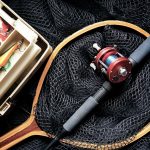1. Comprehend what you can catch
The Park’s primary fishing fascination the Appalachian stream trout, the main local types of trout in the Southeastern United States. Yet, you’ll additionally find wild stream-reared rainbow and darker trout and smallmouth bass. In a solitary day, you can keep up to five trout or smallmouth bass in any mix and these fish should each be no less than seven crawls long. You can likewise catch up to twenty shake bass (there is no base size). Be that as it may, you should quit fishing once this point of confinement has been come to. To quantify a fish, lay it on a level surface with the nose against a flat block, at that point measure from the block to the farthest purpose of the tail.
You ought to know that there are four governmentally ensured fish species in the recreation center, all of which live in bring down Abrams Creek. These incorporate the spotfin chub, duskytail darter, smoky madtom, and yellowfin madtom. Make certain you know how to discharge a fish once again into the water before you start your fishing undertaking.
2. Realize where to fish
You’ll find an assortment of great fishing locations in the Park, from huge, cool water smallmouth bass streams to remote, headwater trout streams. Maps and different details can be acquired at any Park guest focus or officer station or on the web. The best place relies upon the sort of experience you want. Fishing is permitted in all streams in the Tennessee area of the Park, aside from Lynn Camp Prong upstream of its juncture with Thunderhead Prong. Detailed data, including a total list of directions and a guide of fishable stop waters, is additionally accessible at any guest focus or officer station.
3. Utilize the correct gear and lures
It’s essential to recognize what fishing hardware is and isn’t permitted in the Park. Just hand-held rods and single-snare, fake flies or lures might be utilized. Dropper flies are permitted, with up to two flies for every pioneer. Bait fishing isn’t permitted whenever, as it could inadvertently introduce non-local life forms into the water which could hurt the fish. Confined bait incorporates, however, isn’t restricted to, minnows, worms, corn, cheddar, bread, salmon eggs, pork skins or common baits found along streams. The fluid fragrance is additionally prohibited. You are not permitted to utilize twofold, treble, or group snares. Know that all fishing tackle and hardware is liable to investigation whenever.
4. Try to get a license
You will require a legitimate fishing license or allow from either Tennessee or North Carolina to fish in the Great Smoky Mountain National Park. No trout stamp is required. While licenses and allows are not accessible for buy in the Park, they can be acquired in numerous close-by towns or on the web. Extraordinary licenses are required for fishing in Gatlinburg and Cherokee.
Tennessee requires anglers (the two occupants and out-of-state people) to be no less than 13 years old to get a license. On the off chance that you are 65 and more established you can acquire a unique license from the state.
5. Broil the fish
There are various great approaches to cook the trout you catch, however a standout amongst the most well-known mountain strategies is to just sauté it. First, remove the head and gut the fish, however, abstain from evacuating the skin and scales. Roll the trout in flour and your most loved herbs and flavors. Sear the trout at medium to medium-high heat until the point when the skin is brilliant dark colored and the substance is firm and flaky. The spine should turn out effectively once the fish is altogether cooked. Make certain not to overcook – and appreciate! Look at future postings for more great trout formulas.


